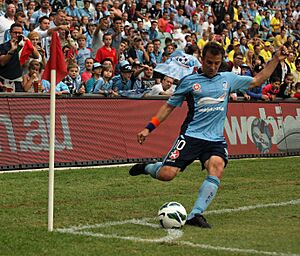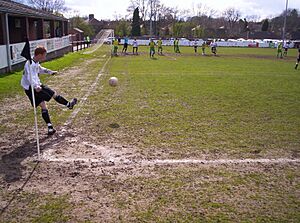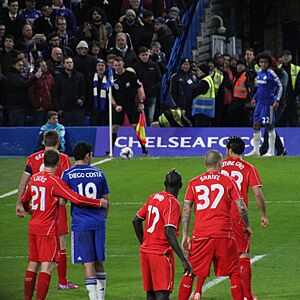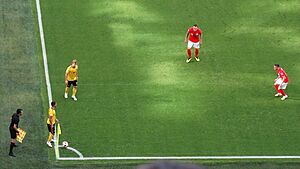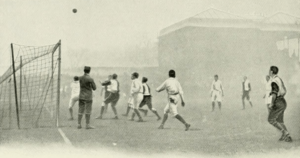Corner kick facts for kids


A corner kick, often just called a corner, is a way to restart a game of association football (soccer). It happens when the ball goes out of play over the goal line (the line at the end of the field where the goals are), but not into the goal. This only happens if the last player to touch the ball was on the defending team. The kick is taken from the corner of the field closest to where the ball went out.
Corner kicks are seen as a good chance for the attacking team to score a goal. They are not as good a chance as a penalty kick, but they are still important.
Sometimes, a player can score a goal directly from a corner kick without anyone else touching the ball. This special type of goal is called an Olimpico goal or Olympic goal.
Contents
When is a Corner Kick Given?
A corner kick is given when the ball completely crosses the goal line (outside the goal frame). This must happen after a player from the defending team last touched the ball. It doesn't matter if they meant to touch it or not.
A corner kick is also given in some rare cases instead of an own goal. This happens if the ball goes into a team's own goal directly from a restart, like a kick-off, a free kick, a throw-in, a goal kick, or even another corner kick. For example, if a player kicks off and the ball somehow goes all the way into their own goal without anyone else touching it, the other team gets a corner kick instead of a goal.
The corner kick is always taken from the corner of the field that is closest to where the ball went out of play.
How to Take a Corner Kick
- The assistant referee (the one with the flag on the side of the field) will first raise their flag. Then, they point it towards the corner area on their side of the field. The main referee will also point to the corner area where the kick should be taken.
- The ball must be still and on the ground. It needs to be inside the corner area. This area is a quarter-circle with a radius of one yard (about 1 meter) from the corner flag.
- All players from the other team must stay at least 10 yards (about 9.15 meters) away from the corner area. They must stay back until the ball is kicked. There might be special marks on the field to help show this 10-yard distance.
- The ball is "in play" as soon as it is kicked and clearly moves. It doesn't need to leave the corner area to be in play.
- The player who takes the corner kick cannot touch the ball a second time. They must wait for another player to touch it first.
- The attacking team can score a goal directly from a corner kick. This is not very common, but it can happen.
- An own goal (scoring in your own net) cannot be scored directly from a corner kick. If a player somehow kicked the ball from a corner all the way into their own goal, the other team would get a corner kick instead.
- An attacking player who gets the ball directly from a corner kick cannot be called offside.
What Happens if Rules are Broken?
If the ball is moving when the kick is taken, or if it's kicked from the wrong spot, the corner kick is taken again.
If opposing players don't move back the required 10 yards quickly, they might get a yellow card (a warning).
A player who takes too long to restart the game (like taking a corner kick) can also get a yellow card.
If the player who took the corner kick touches the ball a second time before another player has touched it, the other team gets an indirect free kick. If the second touch was also a more serious foul (like handling the ball), the other team gets a direct free kick.
Corner Kick Strategies
A common strategy for the attacking team is to have several players stand close to the goal. The player taking the corner then crosses (kicks) the ball high into the air. The attackers try to head the ball into the goal.
The defending team tries to stop this. They might place players near the goalposts to help the goalkeeper protect the goal. This helps cover more of the goal area.
Defending teams also decide how many players to keep back to defend the corner. If they bring all their players back, it's harder for the other team to score. However, this also means they have fewer players ready to counter-attack if they get the ball back.
Sometimes, if a team is losing by only one goal near the end of a game (especially in a knockout tournament), they might send all their players forward for a corner, even the goalkeeper! This is a risky move to try and score a last-minute goal.
Man Marking vs. Zonal Marking
When defending corners, teams often use one of two main strategies:
- Man marking: Each defender is given one attacking player to guard. Their job is to stay with that attacker and stop them from heading the ball.
- Zonal marking: Defenders are each given a specific area (or "zone") in front of the goal to protect. Their goal is to be the first to reach the ball if it enters their zone and kick it away from danger.
Other Tactics
Instead of crossing the ball high, the attacking team might use a short corner. This is when the player taking the corner passes the ball to a teammate who is standing close by. This can create a better angle to attack the goal.
Sometimes, a team that wants to waste time (especially if they are winning near the end of the game) might try to keep the ball in the corner of the field for as long as possible instead of trying to score.
Scoring a Goal Directly from a Corner: Olimpico Goal
It is possible to score a goal directly from a corner kick. This happens if the ball curves enough (because of something called the Magnus effect) or if the wind blows it towards the goal. Usually, if a goal is scored this way, people might think the goalkeeper made a mistake.
This type of goal is called an Olympic goal or Olimpico goal. The rules for this were officially allowed on June 14, 1924. The first such goal was scored on October 2, 1924, by Cesáreo Onzari of Argentina against Uruguay. Uruguay had just won the 1924 Olympic title, which is why it got the name "Olympic goal."
For many years, English speakers called it an Olympic goal. But in recent times, the term Olimpico goal has become more popular. This comes from the Spanish and Portuguese term gol olímpico, which is used a lot in Latin America.
Some Famous Olimpico Goals:
- The first recorded Olimpico goal in England was scored by Billy Smith for Huddersfield Town on October 11, 1924.
- Portuguese player João Morais scored one for Sporting Clube de Portugal in the 1964 European Cup Winners' Cup Final, which helped his team win the trophy.
- Steve Staunton scored two Olimpico goals for the Republic of Ireland in the early 1990s.
- Megan Rapinoe from the United States scored the first Olimpico goal at the Olympic Games in 2012. She scored another one in the 2020 Tokyo Olympics bronze medal match.
- The first Olimpico goal in the men's World Cup was scored by Marcos Coll for Colombia against the Soviet Union in 1962. He scored against Lev Yashin, who is thought to be one of the best goalkeepers ever.
- In January 2012, Paul Owens scored two Olimpico goals in one game in Northern Ireland, helped by strong winds!
- Nguyễn Thị Tuyết Dung from Vietnam scored two direct corner goals in one game in 2015, one with each foot!
- Kyra Cooney-Cross won the 2021 W-League grand final for Melbourne Victory by scoring an Olimpico goal in extra time.
- Katie Zelem of Manchester United women scored two Olimpico goals in a single game in March 2022.
- Douglas Luiz scored two Olimpico goals for Aston Villa in one week in August 2022.
- Katie McCabe scored an Olimpico goal for Republic of Ireland in the 2023 FIFA Women's World Cup group stage.
- James Ward-Prowse scored an Olimpico for West Ham United in a Premier League match in April 2024.
- Christian Pulisic scored an Olimpico for AC Milan in a Champions League game in October 2024.
- Heung-min Son scored an Olimpico for Tottenham Hotspur against Manchester United in a League Cup quarterfinal in December 2024.
Corner Instead of Own Goal from Restart
As mentioned earlier, most ways of restarting the game (like a kick-off or a throw-in) do not allow a team to score an own goal directly. If the ball goes into a team's own net directly from one of these restarts, the other team is usually awarded a corner kick instead of a goal. These situations are very rare!
For example, in a 2002-03 English Premier League match, Birmingham City was given a goal against Aston Villa. This happened when Villa's Olof Mellberg threw the ball back to his goalkeeper, Peter Enckelman, who missed it, and it went into the net. The referee decided it was a goal, even though some argued it should have been a corner kick because a goal cannot be scored directly from a throw-in.
History of the Corner Kick
In the very early days of football (around 1863), if the ball went behind the goal line, it was treated differently. Sometimes it was like rugby, where a team could get a free kick at goal. Later, it was simplified so that a goal kick was always given.
However, there was a problem: if one team was much weaker, they might intentionally kick the ball behind their own goal line to waste time, because they would get a free goal kick.
The Corner Kick is Introduced
The idea of a corner kick was first suggested in a newspaper letter in Sheffield, England, in 1867. The writer argued that the old rule encouraged unfair play. They suggested that if the defending team kicked the ball behind their own goal line, the other team should get a kick from the nearest corner flag.
The corner kick was officially added to the rules in Sheffield football in 1868. At first, it was a bit different from today:
- A corner kick could be given to either the attacking or defending team, depending on who kicked the ball out.
- If the ball went directly over the crossbar (the top part of the goal), the defending team got a goal kick.
In 1872, the Sheffield Football Association successfully got the corner kick added to the main Football Association (FA) rules.
Changes Over Time
In 1873, the FA rule was changed to be more like it is today:
- If the attacking team kicked the ball behind the goal line, the defending team got a goal kick.
- If the defending team kicked the ball behind their own goal line, the attacking team got a corner kick.
The name "corner-kick" first appeared in the rules in 1883. Before that, it was called a "corner-flag kick."
Over the years, other rules about corner kicks also changed:
- Where to kick: At first, it had to be from the corner flag itself. In 1874, it was allowed to be taken from within one yard of the flag.
- Opponent distance: Initially, all other players had to be 6 yards away. In 1888, this changed to only opposing players. In 1913-1914, the distance was increased to 10 yards.
- Ball in play: In 1905, the ball had to make a full circle to be in play. This was removed in 1997, so the ball is in play as soon as it's kicked and moves.
- Offside: In 1883, it was decided that a player cannot be offside directly from a corner kick.
- Scoring directly: Scoring a goal directly from a corner kick was forbidden in 1875, but then made legal again in 1924 (leading to the "Olimpico goal"). In 1997, it became impossible to score an own goal directly from a corner.
- Touching the ball twice: In 1875, it became forbidden for the kicker to touch the ball again before another player touched it. This rule was accidentally removed in 1924 but quickly put back in place in 1925.
Sometimes, in the past, some football tournaments used corner kicks as a way to decide a winner if a match ended in a draw, instead of having a replay. However, this was never officially approved by the main football rule-makers. In 1970, the penalty shoot-out became the official way to break ties.
See also
 In Spanish: Saque de esquina para niños
In Spanish: Saque de esquina para niños
Images for kids
-
1895 painting, "A Corner Kick", by Thomas M.M. Hemy, showing a match between Sunderland and Aston Villa.


